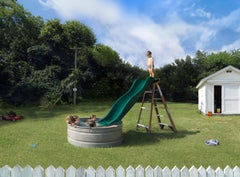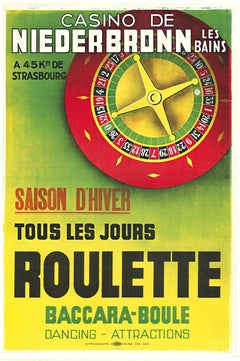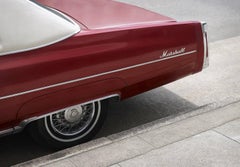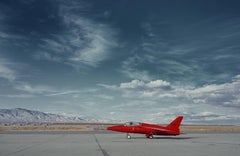Game More Prints
to
2
1
Overall Width
to
Overall Height
to
2
1
1
1
2
1
1
1
2
1
241
200
108
106
98
63
62
52
51
45
36
32
29
23
17
15
15
14
13
11
2
1
1
3
Art Subject: Game
Slide, Color Photograph, Archival Pigment Ink Print, signed and numbered
Located in Sante Fe, NM
Slide by Julie Blackmon is from an ongoing series titled Home Grown
According to the Los Angeles Times, Blackmon's images are “absorbing, meticulously orchestrated slices of ethnogr...
Category
2010s Contemporary Color Photography
Materials
Archival Pigment, Color
Original Casino de Niederbronn Les Bains Roulette vintage poster
Located in Spokane, WA
Original Casino Niederbronn les Bains Vintage Roulette Poster - Classic French Gaming Art. Archival linen-backed in A- condition, ready to frame. Restored fold marks. Excellent...
Category
1940s Art Deco Figurative Prints
Materials
Lithograph
The Degrees of Meaning
Located in New York, NY
The Degrees of Meaning
1973
Signed and numbered, recto
Lithograph
31 x 23.25 inche
This work is offered by CLAMP in New York City.
Category
1970s Contemporary Prints and Multiples
Materials
Lithograph
Related Items
Marshall - large format photograph of iconic cherry red Cadillac automobile
By Frank Schott
Located in San Francisco, CA
large scale photograph of iconic American vintage car with crimson red sheetmetal paint and custom logo tag
Marshall by Frank Schott
25 x 40 inches (64 x 102cm)
signed edition of ...
Category
21st Century and Contemporary Conceptual Color Photography
Materials
Archival Paper, Photographic Paper, Archival Pigment, Archival Ink, Giclée
Red Jet - iconic vintage private jet plane on desert airport tarmac (48 x 74")
By Frank Schott
Located in San Francisco, CA
large format photograph of glossy cherry red vintage private airplane on airport runway tarmac
Red Jet by Frank Schott
48 x 74 inches (122 x 188cm...
Category
21st Century and Contemporary Contemporary Color Photography
Materials
Archival Paper, Photographic Paper, Archival Pigment, Archival Ink, Giclée
H 48 in W 74 in D 0.03 in
Marshall - large format photograph of iconic cherry red Cadillac automobile
By Frank Schott
Located in San Francisco, CA
large scale photograph of iconic American vintage car with crimson red sheetmetal paint and custom logo tag
Marshall by Frank Schott
48 x 75 inches (122 x 191cm)
edition of 7
signed
25 x 40 inches (64 x 102cm)
edition of 25
signed
archival fine art pigment print
signed & numbered by artist on certificate label
Frank Schott was born in Germany where he spends nights shooting the great bands and musicians of the 80s, while attending the Academy of Arts in Cologne under Professor Arno Jansen.
His early photography work focuses on beauty and fashion, later evolving to include conceptual landscapes and large scale environments, while never losing the eye for details.
In 1998 Frank moves to California. He draws inspiration from the epic landscapes and distinct architecture of the American West as much as from his travels abroad.
Edition EKTAlux offers an evolving curated selection of collectable large-scale photography in strictly limited editions, while working closely with each artist to guarantee state-of-the-art museum level print and framing quality.
Custom / larger print sizes available on request
Images can be printed with white border [ 2" L prints & 4" XL prints...
Category
21st Century and Contemporary Contemporary Color Photography
Materials
Archival Paper, Photographic Paper, Archival Pigment, Giclée
Zeppelin - large format photograph of iconic white airship
Located in San Francisco, CA
large format photograph of iconic blimp shaped zeppelin airship
Zeppelin by Christian Stoll
28 x 40 inches (71 x 102cm)
edition of 25
signed
...
Category
21st Century and Contemporary Contemporary Color Photography
Materials
Archival Ink, Archival Paper, Photographic Paper, Archival Pigment
Three Reclining Figures on Pedestals - Lithograph by Henry Moore - 1976
By Henry Moore
Located in Roma, IT
Image dimensions: 38x56 cm.
Lithograph in colors - Signed in pencil lower right - Numbered in pencil lower left (there were also 15 artist’s proofs) - Printed at the Curwen Studio, ...
Category
1970s Contemporary More Prints
Materials
Lithograph
H 19.69 in W 26.58 in D 0.04 in
France World Cup Lithograph by Aldo Luongo c.1998
By Aldo Luongo
Located in San Francisco, CA
FRANCE World Cup Lithograph by Aldo Luongo c.1998
Limited edition France 98' World Cup - Official License
From a very limited edition of 300.
Pencil signed lower right. Edition 24/300 lower left.
This is a rare, very small edition lithograph for the 1998 Soccer World Cup...
Category
Late 20th Century Impressionist Figurative Prints
Materials
Lithograph
An Homage to Monopink, 1960 E
Located in Bristol, GB
Offset lithograph with cold stamp
Edition of 300
Signed and numbered in ink lower right
Mint, as issued
Sold in the original packaging
Category
21st Century and Contemporary Contemporary More Prints
Materials
Lithograph, Offset
Doraemon and Friends Under the Blue Sky
Located in Bristol, GB
Offset lithograph
Edition of 300
Signed and numbered on the front
Mint, as issued
Sold in the original Kaikai Kiki box
Category
21st Century and Contemporary Contemporary More Prints
Materials
Lithograph, Offset
'Tom, Dick & Harry', Paris, Salon d'Automne, Art Deco, Woman Artist, ASL, AIC
By Nura Ulreich
Located in Santa Cruz, CA
A fresh, hand-colored stone lithograph titled 'Tom, Dick and Harry' by Nura Woodson Ulreich (American, 1899-1950), created in 1943 and stamped wit...
Category
1940s Art Deco Figurative Prints
Materials
Paper, Lithograph
Marc Chagall - The Red Rider - Original Lithograph
By Marc Chagall
Located in Collonge Bellerive, Geneve, CH
Marc Chagall - Original Lithograph
The Red Rider
From the unsigned, unnumbered lithograph printed in the literary review XXe Siecle
1957
See Mourlot 191
Dimensions: 32 x 24 cm
Publisher: G. di San Lazzaro.
Marc Chagall (born in 1887)
Marc Chagall was born in Belarus in 1887 and developed an early interest in art. After studying painting, in 1907 he left Russia for Paris, where he lived in an artist colony on the city’s outskirts. Fusing his own personal, dreamlike imagery with hints of the fauvism and cubism popular in France at the time, Chagall created his most lasting work—including I and the Village (1911)—some of which would be featured in the Salon des Indépendants exhibitions. After returning to Vitebsk for a visit in 1914, the outbreak of WWI trapped Chagall in Russia. He returned to France in 1923 but was forced to flee the country and Nazi persecution during WWII. Finding asylum in the U.S., Chagall became involved in set and costume design before returning to France in 1948. In his later years, he experimented with new art forms and was commissioned to produce numerous large-scale works. Chagall died in St.-Paul-de-Vence in 1985.
The Village
Marc Chagall was born in a small Hassidic community on the outskirts of Vitebsk, Belarus, on July 7, 1887. His father was a fishmonger, and his mother ran a small sundries shop in the village. As a child, Chagall attended the Jewish elementary school, where he studied Hebrew and the Bible, before later attending the Russian public school. He began to learn the fundamentals of drawing during this time, but perhaps more importantly, he absorbed the world around him, storing away the imagery and themes that would feature largely in most of his later work.
At age 19 Chagall enrolled at a private, all-Jewish art school and began his formal education in painting, studying briefly with portrait artist Yehuda Pen. However, he left the school after several months, moving to St. Petersburg in 1907 to study at the Imperial Society for the Protection of Fine Arts. The following year, he enrolled at the Svanseva School, studying with set designer Léon Bakst, whose work had been featured in Sergei Diaghilev's Ballets Russes. This early experience would prove important to Chagall’s later career as well.
Despite this formal instruction, and the widespread popularity of realism in Russia at the time, Chagall was already establishing his own personal style, which featured a more dreamlike unreality and the people, places and imagery that were close to his heart. Some examples from this period are his Window Vitebsk (1908) and My Fianceé with Black Gloves (1909), which pictured Bella Rosenfeld, to whom he had recently become engaged.
The Beehive
Despite his romance with Bella, in 1911 an allowance from Russian parliament member and art patron Maxim Binaver enabled Chagall to move to Paris, France. After settling briefly in the Montparnasse neighborhood, Chagall moved further afield to an artist colony known as La Ruche (“The Beehive”), where he began to work side by side with abstract painters such as Amedeo Modigliani and Fernand Léger as well as the avant-garde poet Guillaume Apollinaire. At their urging, and under the influence of the wildly popular fauvism and cubism, Chagall lightened his palette and pushed his style ever further from reality. I and the Village (1911) and Homage to Apollinaire (1912) are among his early Parisian works, widely considered to be his most successful and representative period.
Though his work stood stylistically apart from his cubist contemporaries, from 1912 to 1914 Chagall exhibited several paintings at the annual Salon des Indépendants exhibition, where works by the likes of Juan Gris, Marcel Duchamp and Robert Delaunay were causing a stir in the Paris art world. Chagall’s popularity began to spread beyond La Ruche, and in May 1914 he traveled to Berlin to help organize his first solo exhibition, at Der Sturm Gallery. Chagall remained in the city until the highly acclaimed show opened that June. He then returned to Vitebsk, unaware of the fateful events to come.
War, Peace and Revolution
In August 1914 the outbreak of World War I precluded Chagall’s plans to return to Paris. The conflict did little to stem the flow of his creative output, however, instead merely giving him direct access to the childhood scenes so essential to his work, as seen in paintings such as Jew in Green (1914) and Over Vitebsk (1914). His paintings from this period also occasionally featured images of the war’s impact on the region, as with Wounded Soldier (1914) and Marching (1915). But despite the hardships of life during wartime, this would also prove to be a joyful period for Chagall. In July 1915 he married Bella, and she gave birth to a daughter, Ida, the following year. Their appearance in works such as Birthday (1915), Bella and Ida by the Window (1917) and several of his “Lovers” paintings give a glimpse of the island of domestic bliss that was Chagall’s amidst the chaos.
To avoid military service and stay with his new family, Chagall took a position as a clerk in the Ministry of War Economy in St. Petersburg. While there he began work on his autobiography and also immersed himself in the local art scene, befriending novelist Boris Pasternak, among others. He also exhibited his work in the city and soon gained considerable recognition. That notoriety would prove important in the aftermath of the 1917 Russian Revolution when he was appointed as the Commissar of Fine Arts in Vitebsk. In his new post, Chagall undertook various projects in the region, including the 1919 founding of the Academy of the Arts. Despite these endeavors, differences among his colleagues eventually disillusioned Chagall. In 1920 he relinquished his position and moved his family to Moscow, the post-revolution capital of Russia.
In Moscow, Chagall was soon commissioned to create sets and costumes for various productions at the Moscow State Yiddish Theater, where he would paint a series of murals titled Introduction to the Jewish Theater as well. In 1921, Chagall also found work as a teacher at a school for war orphans. By 1922, however, Chagall found that his art had fallen out of favor, and seeking new horizons he left Russia for good.
Flight
After a brief stay in Berlin, where he unsuccessfully sought to recover the work exhibited at Der Sturm before the war, Chagall moved his family to Paris in September 1923. Shortly after their arrival, he was commissioned by art dealer and publisher Ambroise Vollard to produce a series of etchings for a new edition of Nikolai Gogol's 1842 novel Dead Souls. Two years later Chagall began work on an illustrated edition of Jean de la Fontaine’s Fables, and in 1930 he created etchings for an illustrated edition of the Old Testament, for which he traveled to Palestine to conduct research.
Chagall’s work during this period brought him new success as an artist and enabled him to travel throughout Europe in the 1930s. He also published his autobiography, My Life (1931), and in 1933 received a retrospective at the Kunsthalle in Basel, Switzerland. But at the same time that Chagall’s popularity was spreading, so, too, was the threat of Fascism and Nazism. Singled out during the cultural "cleansing" undertaken by the Nazis in Germany, Chagall’s work was ordered removed from museums throughout the country. Several pieces were subsequently burned, and others were featured in a 1937 exhibition of “degenerate art” held in Munich. Chagall’s angst regarding these troubling events and the persecution of Jews in general can be seen in his 1938 painting White Crucifixion.
With the eruption of World War II, Chagall and his family moved to the Loire region before moving farther south to Marseilles following the invasion of France. They found a more certain refuge when, in 1941, Chagall’s name was added by the director of the Museum of Modern Art (MOMA) in New York City to a list of artists and intellectuals deemed most at risk from the Nazis’ anti-Jewish campaign. Chagall and his family would be among the more than 2,000 who received visas and escaped this way.
Haunted Harbors
Arriving in New York City in June 1941, Chagall discovered that he was already a well-known artist there and, despite a language barrier, soon became a part of the exiled European artist community. The following year he was commissioned by choreographer Léonide Massine to design sets and costumes for the ballet Aleko, based on Alexander Pushkin’s “The Gypsies” and set to the music of Pyotr Ilyich Tchaikovsky.
But even as he settled into the safety of his temporary home, Chagall’s thoughts were frequently consumed by the fate befalling the Jews of Europe and the destruction of Russia, as paintings such as The Yellow Crucifixion...
Category
1950s Surrealist Figurative Prints
Materials
Lithograph
Eight Sculptural Ideas - Lithograph by Henry Moore - 1973
By Henry Moore
Located in Roma, IT
Eight Sculptural Ideas is an original lithograph realized by the British artist Henry Moore (Castleford, 1898 - Much Hadham, 1986).
Hand-signed and...
Category
1970s Contemporary More Prints
Materials
Paper, Lithograph
H 19.69 in W 25.4 in D 0.04 in
Alcyon Cycles-Moto Vintage Poster
By Georges Favre
Located in Paonia, CO
Alcyon Cycles-Moto is an original lithographic poster by George Farve in very good condition and published Affiches Gaillard-Paris-Amiens. The type under the image reads Nos Bicyclet...
Category
20th Century Art Deco Figurative Prints
Materials
Lithograph




